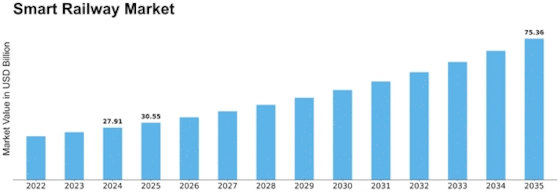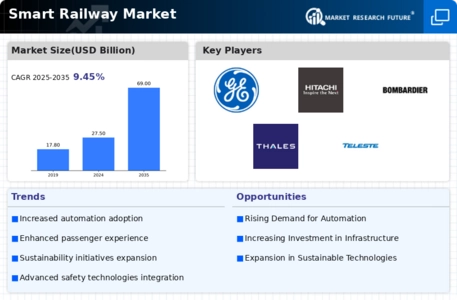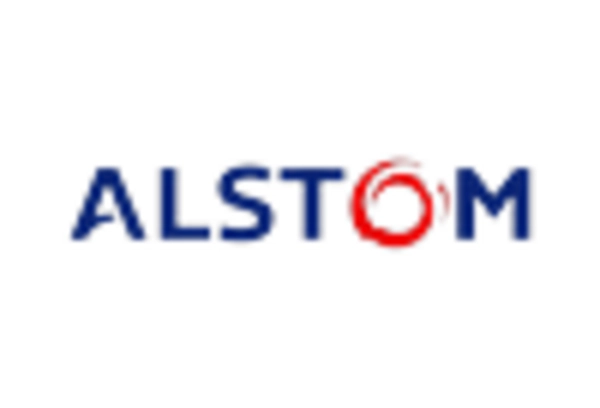-
Executive Summary
-
Market Introduction
-
Definition
-
Scope Of The Study
-
Market Structure
-
Research Methodology
-
Research Process
-
List Of Assumptions
-
Forecast Model
-
Market Dynamics
-
Introduction
-
Drivers
- Increasing Adoption Of IoT
- Growing Demand For Cloud-Based Services
- Increasing Growth Of Hyper-Urbanization
- Drivers Impact Analysis
-
Restraint
- Lack Of ICT Infrastructure
- Restraints Impact Analysis
-
Opportunities
- Emerging Trend Of Smart Cities
-
Market Factor Analysis
-
Smart Railways Infrastructure Framework
-
Supply Chain Analysis – Global Smart Railways Market
- OEMs And ODMs
- Hardware And Control Systems
- Software/Application Developers
- Network & Cloud Services
- System Integrators
- End-Users
-
Porter’s Five Forces Model
- Threat Of New Entrants
- Bargaining Power Of Suppliers
- Bargaining Power Of Buyers
- Threat Of Substitutes
- Intensity Of Rivalry
-
Global Smart Railway Market, By Type
-
Overview
-
Station Type By Sub-Segment
- By Component
- By Service
- By Solution
-
On-Board Trains, By Sub-Segment
- By Component
- By Service
- By Solution
-
Global Smart Railway Market, By Component
-
Introduction
-
Networking & Connectivity Devices
-
Control And Maintenance
-
Video Surveillance Cameras
-
Multimedia Infotainment Devices
-
Others
-
Global Smart Railway Market, By Services
-
Introduction
-
Consulting Services
-
System Integration & Deployment
-
Support & Maintenance
-
Global Smart Railway Market, By Solution
-
Introduction
-
Smart Ticketing System
-
Rail Communication & Networking System
-
Advanced Security Monitoring System
-
Passenger Information System
-
Rail Analytics System
-
Freight Information System
-
Smart Railway Market, By Region
-
Introduction
-
North America
- US.
- Canada
- Mexico
-
Europe
- UK
- Germany
- Rest Of Europe
- France
-
Asia-Pacific
- Japan
- China
- Rest Of Asia-Pacific
- India
-
Rest Of The World (ROW)
- The Middle East & Africa
- South America
-
Competitive Landscape
-
Competitive Landscape
-
Company Profile
-
Alstom SA
- Company Overview
- Financial Overview
- Products Offerings
- Key Developments (2020–2027)
- SWOT Analysis
- Key Strategies
-
Cisco Systems Inc
- Company Overview
- Financial Overview
- Products Offerings
- Key Developments (2020–2027)
- SWOT Analysis
- Key Strategies
-
General Electric
- Company Overview
- Financial Overview
- Products Offerings
- Key Developments (2020–2027)
- SWOT Analysis
- Key Strategies
-
IBM Corporation
- Company Overview
- Financial Overview
- Products Offerings
- Key Developments (2020–2027)
- SWOT Analysis
- Key Strategies
-
Hitachi Ltd
- Company Overview
- Financial Overview
- Products Offerings
- Key Developments
- SWOT Analysis
- Key Strategies
-
Huawei Technologies Co. Ltd
- Company Overview
- Financial Overview
- Products Offerings
- Key Developments
- SWOT Analysis
- Key Strategies
-
Siemens AG
- Company Overview
- Financial Overview
- Products Offerings
- Key Developments (2020–2027)
- SWOT Analysis
- Key Strategies
-
Bombardier, Inc.
- Company Overview
- Financial Overview
- Products Offerings
- Key Developments
- SWOT Analysis
- Key Strategies
-
Indra Sistemas SA
- Company Overview
- Financial Overview
- Products Offerings
- Key Developments
- SWOT Analysis
- Key Strategies
-
ABB Ltd
- Company Overview
- Financial Overview
- Products Offerings
- Key Developments (2020–2027)
- SWOT Analysis
- Key Strategies
-
Teleste
- Company Overview
- Financial Overview
- Products Offerings
- Key Developments (2020–2027)
- SWOT Analysis
- Key Strategies
-
Thales Group
- Company Overview
- Financial Overview
- Products Offerings
- Key Developments (2020–2027)
-
List Of Tables
-
LIST OF ASSUMPTIONS
-
GLOBAL SMART RAILWAY MARKET, BY TYPE, 2020–2027 (USD MILLION)
-
GLOBAL SMART RAILWAY STATIONS MARKET, BY COMPONENT, 2020–2027 (USD MILLION)
-
GLOBAL SMART RAILWAY STATIONS MARKET, BY SERVICE, 2020–2027 (USD MILLION)
-
GLOBAL SMART RAILWAY STATIONS MARKET, BY SOLUTION, 2020–2027 (USD MILLION)
-
GLOBAL SMART RAILWAY ON-BOARD TRAINS MARKET, BY COMPONENT, 2020–2027 (USD MILLION)
-
GLOBAL SMART RAILWAY ON-BOARD TRAINS MARKET, BY SERVICE, 2020–2027 (USD MILLION)
-
GLOBAL SMART RAILWAY ON-BOARD TRAINS MARKET, BY SOLUTION, 2020–2027 (USD MILLION)
-
GLOBAL SMART RAILWAY MARKET, BY COMPONENT, 2020–2027 (USD MILLION)
-
GLOBAL SMART RAILWAY MARKET, BY SERVICES, 2020–2027 (USD MILLION)
-
GLOBAL SMART RAILWAY MARKET, BY SOLUTION, 2020–2027 (USD MILLION)
-
GLOBAL SMART RAILWAY MARKET, BY REGION, 2020–2027 (USD MILLION)
-
NORTH AMERICA: SMART RAILWAY MARKET, BY COUNTRY, 2020–2027 (USD MILLION)
-
NORTH AMERICA SMART RAILWAY MARKET, BY TYPE, 2020–2027 (USD MILLION)
-
NORTH AMERICA SMART RAILWAY MARKET, BY COMPONENT, 2020–2027 (USD MILLION)
-
NORTH AMERICA SMART RAILWAY MARKET, BY SERVICE, 2020–2027 (USD MILLION)
-
NORTH AMERICA SMART RAILWAY MARKET, BY SOLUTION, 2020–2027 (USD MILLION)
-
US: SMART RAILWAY MARKET, BY TYPE, 2020–2027 (USD MILLION)
-
US: SMART RAILWAY MARKET, BY COMPONENT, 2020–2027 (USD MILLION)
-
US: SMART RAILWAY MARKET, BY SERVICES, 2020–2027 (USD MILLION)
-
US: SMART RAILWAY MARKET, BY SOLUTION, 2020–2027 (USD MILLION)
-
CANADA SMART RAILWAY MARKET, BY TYPE, 2020–2027 (USD MILLION)
-
CANADA SMART RAILWAY MARKET, BY COMPONENT, 2020–2027 (USD MILLION)
-
CANADA SMART RAILWAY MARKET, BY SERVICES, 2020–2027 (USD MILLION)
-
CANADA SMART RAILWAY MARKET, BY SOLUTION, 2020–2027 (USD MILLION)
-
MEXICO: SMART RAILWAY MARKET, BY TYPE, 2020–2027 (USD MILLION)
-
MEXICO: SMART RAILWAY MARKET, BY COMPONENT, 2020–2027 (USD MILLION)
-
MEXICO: SMART RAILWAY MARKET, BY SERVICES, 2020–2027 (USD MILLION)
-
MEXICO: SMART RAILWAY MARKET, BY SOLUTION, 2020–2027 (USD MILLION)
-
EUROPE SMART RAILWAY MARKET, BY COUNTRY, 2020–2027 (USD MILLION)
-
EUROPE SMART RAILWAY MARKET, BY TYPE, 2020–2027 (USD MILLION)
-
EUROPE SMART RAILWAY MARKET, BY COMPONENT, 2020–2027 (USD MILLION)
-
EUROPE SMART RAILWAY MARKET, BY SERVICE, 2020–2027 (USD MILLION)
-
EUROPE SMART RAILWAY MARKET, BY SOLUTION, 2020–2027 (USD MILLION)
-
THE UK SMART RAILWAY MARKET, BY TYPE, 2020–2027 (USD MILLION)
-
THE UK SMART RAILWAY MARKET, BY COMPONENT, 2020–2027 (USD MILLION)
-
THE UK SMART RAILWAY MARKET, BY SERVICES, 2020–2027 (USD MILLION)
-
THE UK SMART RAILWAY MARKET, BY SOLUTION, 2020–2027 (USD MILLION)
-
GERMANY SMART RAILWAY MARKET, BY TYPE, 2020–2027 (USD MILLION)
-
GERMANY SMART RAILWAY MARKET, BY COMPONENT, 2020–2027 (USD MILLION)
-
GERMANY SMART RAILWAY MARKET, BY SERVICES, 2020–2027 (USD MILLION)
-
GERMANY SMART RAILWAY MARKET, BY SOLUTION, 2020–2027 (USD MILLION)
-
REST OF EUROPE SMART RAILWAY MARKET, BY TYPE, 2020–2027 (USD MILLION)
-
REST OF EUROPE SMART RAILWAY MARKET, BY COMPONENT, 2020–2027 (USD MILLION)
-
REST OF EUROPE SMART RAILWAY MARKET, BY SERVICES, 2020–2027 (USD MILLION)
-
REST OF EUROPE SMART RAILWAY MARKET, BY SOLUTION, 2020–2027 (USD MILLION)
-
FRANCE SMART RAILWAY MARKET, BY TYPE, 2020–2027 (USD MILLION)
-
FRANCE SMART RAILWAY MARKET, BY COMPONENT, 2020–2027 (USD MILLION)
-
FRANCE SMART RAILWAY MARKET, BY SERVICES, 2020–2027 (USD MILLION)
-
FRANCE SMART RAILWAY MARKET, BY SOLUTION, 2020–2027 (USD MILLION)
-
ASIA-PACIFIC SMART RAILWAY MARKET, BY COUNTRY, 2020–2027 (USD MILLION)
-
ASIA-PACIFIC SMART RAILWAY MARKET, BY TYPE, 2020–2027 (USD MILLION)
-
ASIA-PACIFIC SMART RAILWAY MARKET, BY COMPONENT, 2020–2027 (USD MILLION)
-
ASIA-PACIFIC SMART RAILWAY MARKET, BY SERVICE, 2020–2027 (USD MILLION)
-
ASIA-PACIFIC SMART RAILWAY MARKET, BY SOLUTION, 2020–2027 (USD MILLION)
-
JAPAN SMART RAILWAY MARKET, BY TYPE, 2020–2027 (USD MILLION)
-
JAPAN SMART RAILWAY MARKET, BY COMPONENT, 2020–2027 (USD MILLION)
-
JAPAN SMART RAILWAY MARKET, BY SERVICES, 2020–2027 (USD MILLION)
-
JAPAN SMART RAILWAY MARKET, BY SOLUTION, 2020–2027 (USD MILLION)
-
CHINA SMART RAILWAY MARKET, BY TYPE, 2020–2027 (USD MILLION)
-
CHINA SMART RAILWAY MARKET, BY COMPONENT, 2020–2027 (USD MILLION)
-
CHINA SMART RAILWAY MARKET, BY SERVICES, 2020–2027 (USD MILLION)
-
CHINA SMART RAILWAY MARKET, BY SOLUTION, 2020–2027 (USD MILLION)
-
REST OF ASIA-PACIFIC SMART RAILWAY MARKET, BY TYPE, 2020–2027 (USD MILLION)
-
REST OF ASIA-PACIFIC SMART RAILWAY MARKET, BY COMPONENT, 2020–2027 (USD MILLION)
-
REST OF ASIA-PACIFIC SMART RAILWAY MARKET, BY SERVICES, 2020–2027 (USD MILLION)
-
REST OF ASIA-PACIFIC SMART RAILWAY MARKET, BY SOLUTION, 2020–2027 (USD MILLION)
-
INDIA SMART RAILWAY MARKET, BY TYPE, 2020–2027 (USD MILLION)
-
INDIA SMART RAILWAY MARKET, BY COMPONENT, 2020–2027 (USD MILLION)
-
INDIA SMART RAILWAY MARKET, BY SERVICES, 2020–2027 (USD MILLION)
-
INDIA SMART RAILWAY MARKET, BY SOLUTION, 2020–2027 (USD MILLION)
-
REST OF THE WORLD (ROW) SMART RAILWAY MARKET, BY COUNTRY, 2020–2027 (USD MILLION)
-
REST OF THE WORLD (ROW) SMART RAILWAY MARKET, BY TYPE, 2020–2027 (USD MILLION)
-
REST OF THE WORLD (ROW) SMART RAILWAY MARKET, BY COMPONENT, 2020–2027 (USD MILLION)
-
REST OF THE WORLD (ROW) SMART RAILWAY MARKET, BY SERVICE, 2020–2027 (USD MILLION)
-
REST OF THE WORLD (ROW) SMART RAILWAY MARKET, BY SOLUTION, 2020–2027 (USD MILLION)
-
THE MIDDLE EAST & AFRICA SMART RAILWAY MARKET, BY TYPE, 2020–2027 (USD MILLION)
-
THE MIDDLE EAST & AFRICA SMART RAILWAY MARKET, BY COMPONENT, 2020–2027 (USD MILLION)
-
THE MIDDLE EAST & AFRICA SMART RAILWAY MARKET, BY SERVICES, 2020–2027 (USD MILLION)
-
THE MIDDLE EAST & AFRICA SMART RAILWAY MARKET, BY SOLUTION, 2020–2027 (USD MILLION)
-
SOUTH AMERICA SMART RAILWAY MARKET, BY TYPE, 2020–2027 (USD MILLION)
-
SOUTH AMERICA SMART RAILWAY MARKET, BY COMPONENT, 2020–2027 (USD MILLION)
-
SOUTH AMERICA SMART RAILWAY MARKET, BY SERVICES, 2020–2027 (USD MILLION)
-
SOUTH AMERICA SMART RAILWAY MARKET, BY SOLUTION, 2020–2027 (USD MILLION)
-
List Of Figures
-
GLOBAL SMART RAILWAY MARKET: MARKET STRUCTURE
-
TOP DOWN & BOTTOM UP APPROACH
-
DROC ANALYSIS OF GLOBAL SMART RAILWAY MARKET
-
DRIVERS IMPACT ANALYSIS: SMART RAILWAY MARKET
-
RESTRAINTS IMPACT ANALYSIS: ABC MARKET
-
SMART RAILWAYS INFRASTRUTURE FRAMEWORK
-
SMART RAILWAYS INFRASTRUTURE FRAMEWORK
-
PORTER''S FIVE FORCES ANALYSIS OF THE GLOBAL SMART RAILWAY MARKET
-
GLOBAL SMART RAILWAY MARKET, BY TYPE, 2020 – 2027 (USD MILLION)
-
GLOBAL SMART RAILWAY MARKET, BY COMPONENT, 2020–2027 (USD MILLION)
-
GLOBAL SMART RAILWAY MARKET, BY SERVICES, 2020–2027 (USD MILLION)
-
GLOBAL SMART RAILWAY MARKET, BY SOLUTION, 2020–2027 (USD MILLION)
-
GLOBAL SMART RAILWAY MARKET, BY REGION, 2020–2027 (USD MILLION)
-
NORTH AMERICA: SMART RAILWAY MARKET, BY COUNTRY, 2020–2027 (USD MILLION)
-
NORTH AMERICA SMART RAILWAY MARKET, BY TYPE, 2027–2027 (USD MILLION)
-
NORTH AMERICA SMART RAILWAY MARKET, BY COMPONENT, 2020–2027 (USD MILLION)
-
NORTH AMERICA SMART RAILWAY MARKET, BY SERVICE, 2020–2027 (USD MILLION)
-
NORTH AMERICA SMART RAILWAY MARKET, BY SOLUTION, 2020–2027 (USD MILLION)
-
EUROPE: SMART RAILWAY MARKET, BY COUNTRY, 2020–2027 (USD MILLION)
-
EUROPE SMART RAILWAY MARKET, BY TYPE, 2020–2027 (USD MILLION)
-
EUROPE SMART RAILWAY MARKET, BY COMPONENT, 2020–2027 (USD MILLION)
-
EUROPE SMART RAILWAY MARKET, BY SERVICE, 2020–2027 (USD MILLION)
-
EUROPE SMART RAILWAY MARKET, BY SOLUTION, 2020–2027 (USD MILLION)
-
ASIA-PACIFIC SMART RAILWAY MARKET, BY COUNTRY, 2020 – 2027 (USD MILLION)
-
ASIA-PACIFIC SMART RAILWAY MARKET, BY TYPE, 2020–2027 (USD MILLION)
-
ASIA-PACIFIC SMART RAILWAY MARKET, BY COMPONENT, 2020–2027 (USD MILLION)
-
ASIA-PACIFIC SMART RAILWAY MARKET, BY SERVICE, 2020–2027 (USD MILLION)
-
ASIA-PACIFIC SMART RAILWAY MARKET, BY SOLUTION, 2020–2027 (USD MILLION)
-
REST OF THE WORLD (ROW) SMART RAILWAY MARKET, BY COUNTRY, 2020–2027 (USD MILLION)
-
REST OF THE WORLD (ROW) SMART RAILWAY MARKET, BY TYPE, 2020–2027 (USD MILLION)
-
REST OF THE WORLD (ROW) SMART RAILWAY MARKET, BY COMPONENT, 2020–2027 (USD MILLION)
-
REST OF THE WORLD (ROW) SMART RAILWAY MARKET, BY SERVICE, 2020–2027 (USD MILLION)
-
REST OF THE WORLD (ROW) SMART RAILWAY MARKET, BY SOLUTION, 2020–2027 (USD MILLION)
-
GLOBAL SMART RAILWAYS MARKET KEY PLAYERS MARKET SHARE, 2020 (%)










Leave a Comment